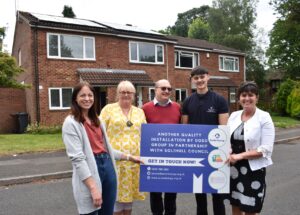‘Significant’ drop in NO2 recorded on Putney High Street
Provisional data published by Wandsworth council suggests that pollution on Putney High Street has fallen dramatically, a fall that the council has attributed to action against highly-polluting buses.
According to the readings taken between February and June using a kerbside monitor, EU hourly nitrogen dioxide (NO2) limit objectives were exceeded on just six occasions, all of which fell in February.

Putney High Street was declared a Low Emission Bus Zone in March (Picture: @MayorofLondon)
This compares to 742 times during the same six month period in 2016 and 640 times in 2015.
The council’s other high street monitoring station, which is mounted to a building façade further from traffic, recorded zero hourly pollution episodes since the start of February, according to the local authority. This compares to 200 last year and 135 in 2015.
Wandsworth council has stressed that the data is provisional and could be subject to change, as well as pointing out that pollution episodes in January mean that the area has already breached the annual legal limit, which is set at 18 breaches of the hourly limit per year.
The council was unable to directly compare figures for January 2016 and 2017 due to some problems with the recording of the data in 2017, a spokesman for the council said.

According to the authority, the fall in pollution coincides with the introduction of cleaner buses along the street which have been put into service in recent years.
This includes the designation of Putney High Street as a ‘Low Emission Bus Zone’. Since March only buses that meet the Euro VI emissions standard have been permitted to run within the Putney Low Emission Bus Zone.
Buses
As such, older diesel buses are not used on the route between Putney Station and Putney Bridge Road. 11 more Low Emission Bus Zones are due to be rolled out in the capital by 2020, in areas including Brixton, Streatham, Shepherds Bush and Stratford.
Improvements to street layout and traffic signals have also been made to ease queuing and restrictions on delivery vehicles stopping to unload have also been introduced to reduce congestion further.
Commenting on the figures, Wandsworth’s deputy council leader, Councillor Jonathan Cook said: “These provisional results are encouraging but our goal is to meet the EU pollution limit and we’re not there yet. It looks like our campaign to ban polluting buses from Putney High Street has had a major impact and our ban on daytime deliveries could also be a significant factor is cutting the congestion which contributes to pollution build ups.
“However we can’t accept older polluting buses simply being switched to other routes and we want assurances from the Mayor that he has stopped this divisive policy. Trading one community’s health for another’s is wrong and we want to be sure that polluting buses are being taken off our streets altogether.”
The council is now pushing for the removal of high emission buses from other pollution hotspots within the borough, including Clapham Junction and Tooting where buses represent a high proportion of the traffic flow.
‘Encouraging’
Publication of the provisional data from Wandsworth has been welcomed by City Hall, which has claimed shows that initiatives such as the Low Emission Bus Zone are contributing to improvements in air quality in London.
A spokesperson for the Mayor of London said: “It is encouraging to see that the since the introduction of the Mayor’s Low Emission Bus Zone in March there has been a dramatic reduction in pollution levels on Putney High Street, therefore improving the health and wellbeing of people in the local area.
“These figures show that the Mayor’s plans to clean up London’s air, including introducing Low Emission Bus Zones, are making a real difference.
“As part of these bold plans, TfL is in the process of ensuring that the dirtiest and most polluting buses are removed from the streets of London.”
















